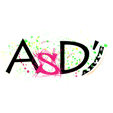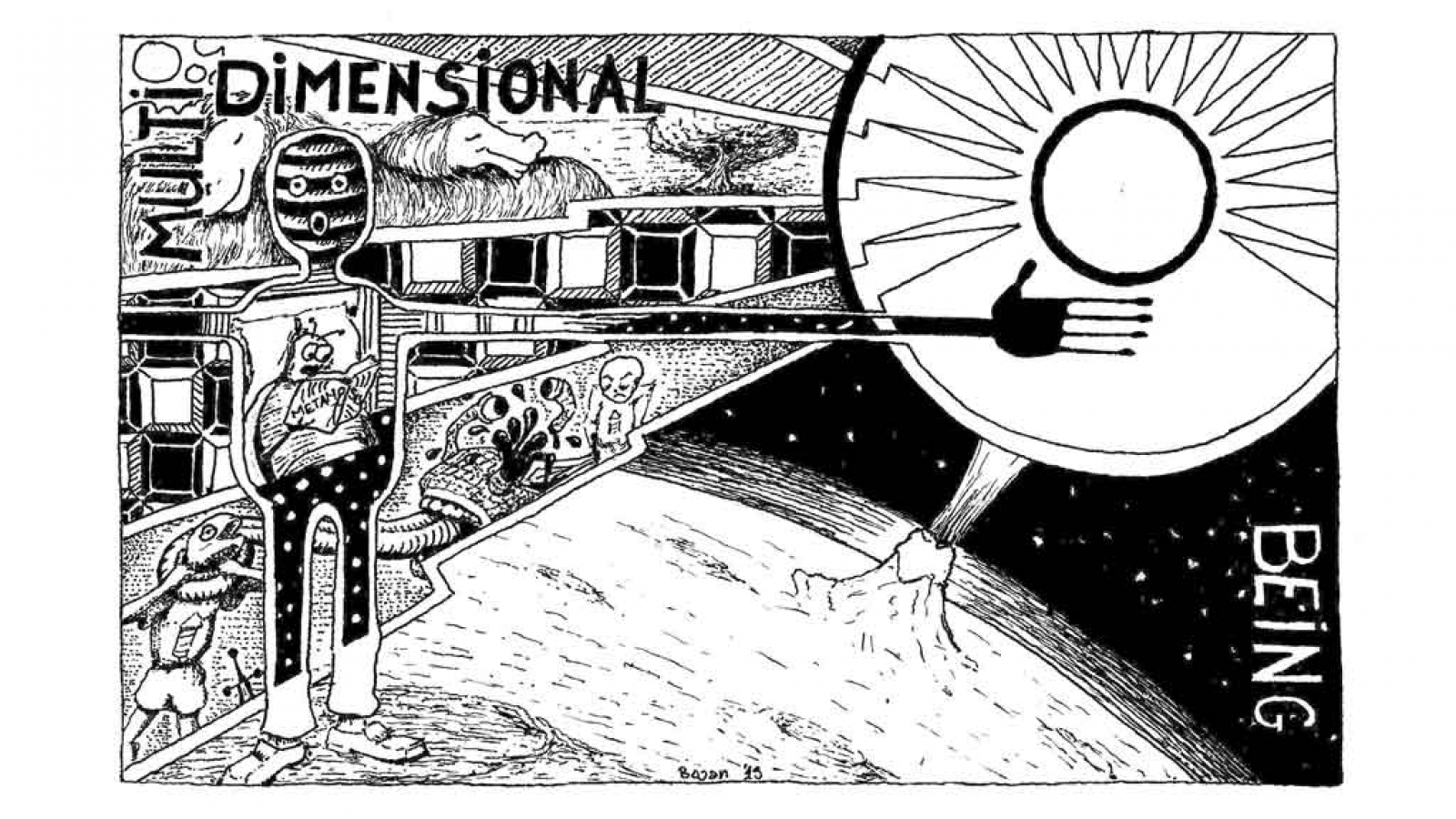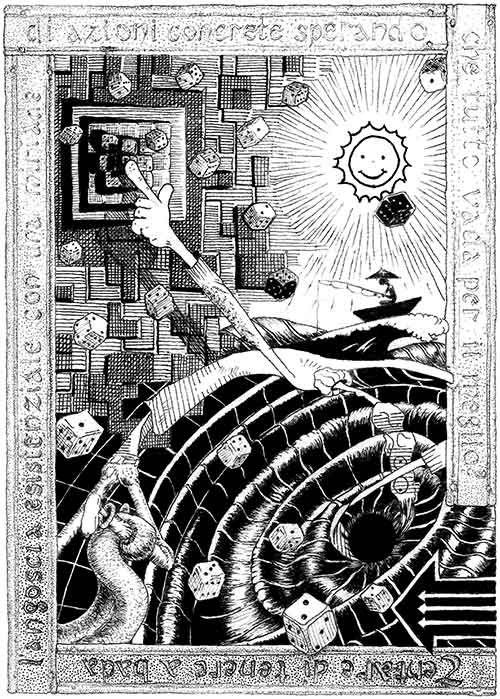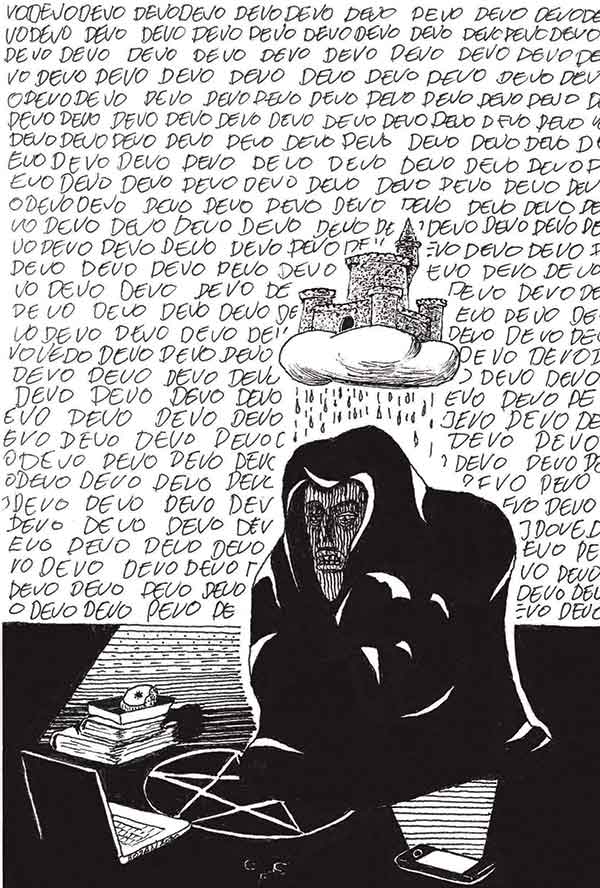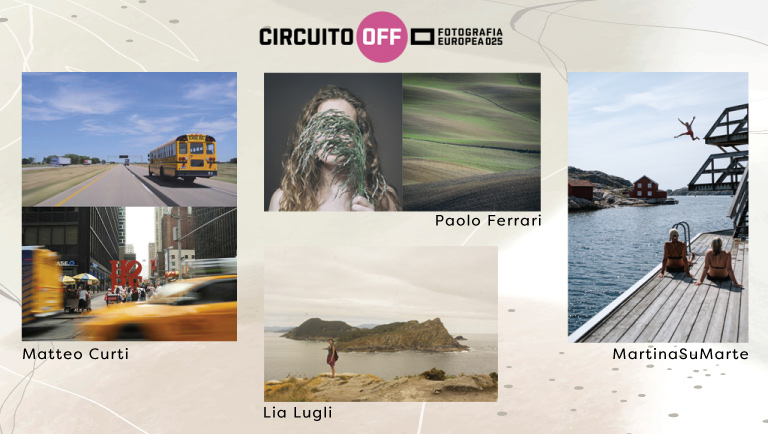Bojan Mitrovic is an artist, a historian and a translator doing mostly ink drawings in the last four years. In his project “Mezzo gaudio” he deals with the inner world, depicting characters who question themselves.
Short presentation.
«My name is Bojan Mitrović, I am a 46-year-old historian and translator and I have a complicated relationship with many things, including drawing. I picked up a pen on a more regular basis about 4 years ago, when a long-time friend (Vladan Miljković) asked me to illustrate his poetry book, “Kraftverk u Audiju” (Belgrade, 2021), where the Serbian title has the double meaning of both Kraftwerk simply listened to, and Kraftwerk listened to in an Audi car. After finishing these drawings, (the book had a long gestation) I still wanted to draw and I was looking for a subject. It was at this point that the famous phrase of Philip K.Dick flashed in my mind, that “the only problem with introspection is that it can last forever”. And so I said to myself: “Great, I found a perpetual subject, a topic that cannot be exhausted”».
Let’s talk about your project “Mezzo gaudio”…
«It is precisely from this orientation that the works collected in the exhibition “Mezzo gaudio” (Half a Joy) in the “Spazio MOON” in Trieste, in October 2020, were born. As a product of introspection, “Mezzo gaudio” is a potentially infinite project. The next exhibitions of this cycle, in homage to the B-movies, will have the number after the title, so there will be a “Mezzo gaudio 2”, a “Mezzo gaudio 3” etc. I really like a school of psychotherapy called Internal Family Systems Therapy, which postulates the non-existence of the monolithic individual. This is replaced by different personalities who live in each of us, which the practitioner is invited to discover. Consequently, the mechanisms of psychological life resemble more a parliament than a monarchy. Several drawings of the cycle “Mezzo gaudio” are portraits of these inner characters. Other drawings, however, are descriptions of situations seen only in their intimate reality, without the triggering event, which I would instead call interior landscapes. What I try to do is to transform, through graphic rethinking and communication, even the worst experiences into something pleasant, from which comes the title of the exhibition: “Mezzo gaudio” (Half a Joy)».
How would you describe your style.
«The truth is, I don’t know. My Instagram profile is called Naif Ink, and maybe that’s enough, in the sense that I’m a self-taught artist making ink drawings. I am interested in expressing myself, even on issues which are difficult to speak about, much more than I am interested in developing a style».
How are your illustrations born.
«There is almost always an interaction between the image and the word. True, I have been doing urban sketching for some time now and I also do automatic drawings, to improve the technique and speed in the first case and to bring out the subconscious in a sharper way in the second. I think that a few of these exercises might have something to them and maybe one day I will also do two different exhibitions of these works, but I tend to see them as a means rather than an end. What interests me above all is a rational investigation of the inner world. For this reason, very often in the construction phase in pencil, I also use a ruler, not only to define the edges, but also to create focal points and internal subdivisions and therefore emphasise this element of rationality. The initial idea is almost always described in words, as a note on my mobile phone. This verbal part allows me, unlike most of the artists I’ve had the pleasure to meet, to detach myself from the drawing and continue at a later time without the fear of forgetting what to do next. So when the construction phase begins, I already have beside me at least another sheet of paper, for calculations, drafts and inking tests. These sheets stay with the drawing until it is finished. The final step is the inking propper, and I mostly use markers and technical pens, but on the other hand I think this process is quite common for anyone drawing in black and white. I do not use whites, razors or other tools to correct the ink and the only white present is that of the sheet of paper. This might seem a bit crazy and, of course, it is a completely pointless self-imposed limitation, but it is precisely the attention of not making mistakes that makes me relax while inking».
Is there a single work you like the most?
«I should probably give the old songwriters’ answer and say: “the last one”. And that would be true for at least two reasons. On the one hand, drawing as introspection is a process of self-care, and with each drawing I understand something new about myself and others. In fact, at the end of each drawing, there is a period in which the drawing “works on me”, in which I go back to look at it, I keep it in mind even in the smallest details and I try to apply it in everyday life. I try to be guided in life by the drawings I make and to recognize the situations through the drawings I have already made. For this reason, every piece has a special importance to me at the moment in which it is born and when I move on to something new,It means, even quite literally, that I have turned over a new leaf. On the other hand in all honesty, in my artwork, I still see a great deal of room for technical growth and it is a margin that I try to reduce. Although the pure drawing skills are not really my focal point, I always try to bring more technical quality to each new piece».
What’s your artistic message.
«Maybe it’s hidden in the fact that I lied in answering the previous question. My programmatic drawing is the first one, namely “Multidimensional Being” which has also been published in Vladan’s book. It is a drawing that claims the right to deal with different things in life, to have a multitude of interests and also to recognize that you are not always the same person at all times, but above all, it is a drawing that claims the right to feel confused with all this».
What should never be missing while working?
«At regular intervals I need tobacco, unfortunately».
Are you working on any particular project or would you like to do so?
«I periodically transfer the notes from my phone to a Word document because, otherwise, they become unmanageable. I do not know if the ideas get angry if other ideas jump the queue, but very often, those waiting to be realized are bypassed by other, new ideas I feel the urgency to work on. Very slowly, I’m coming out of my shell and addressing issues more related to relationships with others. I assume that at some point the artwork that speaks about other people will come to form a cycle of it’s own, but that hasn’t happened yet, and so this cycle doesn’t have a name.
Instead, I do have a name, but not yet the full project, for a cycle of 15 drawings on climate change that will be called “Ecocalypse”. Both as a historian and as a boy who came of age at the time of the Yugoslav Wars, what scares me most about global warming is not what we are doing to the environment, nor what, in terms of natural disasters, the planet will do to us, but I’m deeply concerned about what we are going to do to each other once we realize that there’s nothing left to gain. And, at the end of the day, I’m just a guy who deals with his anxieties through drawing».
A curiosity before leaving us.
«I was born and raised in Belgrade (Serbia), but have spent more than half my life with some relatively short interruptions, in Trieste».
Link of artist
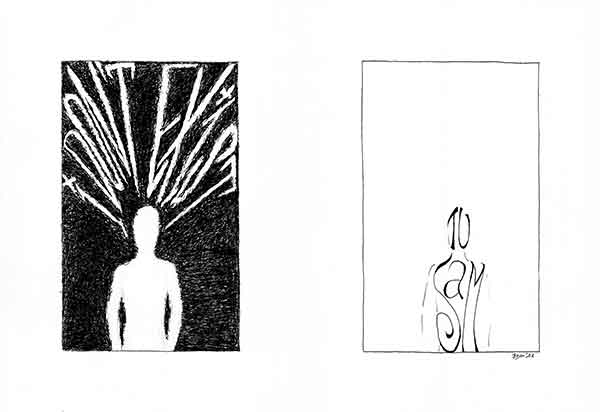
Watch video we dedicated to him
Intervista in italiano
Il disegno come introspezione, un racconto di sé e degli altri
Bojan Mitrovic è un artista, uno storico e un traduttore e da quattro anni si dedica all’illustrazione. Nel suo progetto “Mezzo gaudio” affronta il tema dell’analisi interiore proponendo opere raffiguranti personaggi che si interrogano su se stessi.
Breve presentazione.
«Mi chiamo Bojan Mitrovic e sono uno storico e traduttore di 46 anni. Ho un rapporto complicato con tante cose, incluso il disegno. Ho ripreso in mano il pennarello in modo più continuativo circa 4 anni fa, quando un amico di vecchia data (Vladan Miljković) mi ha chiesto di illustrare il suo libro di poesie, “Kraftverk u Audiju” (Belgrado, 2021), dove il titolo serbo ha il doppio senso sia di Kraftwerk semplicemente “ascoltati”, sia di Kraftwerk “ascoltati in una macchina Audi”. Dopo aver finito questi disegni, (il libro ha avuto una lunga gestazione) mi è rimasta la voglia di disegnare e cercavo un soggetto. È a questo punto che mi era balenata nella mente la famosa frase di Philip K.Dick, che “l’unico problema con l’introspezione sta nel fatto che può durare in eterno”. Mi sono detto: ottimo, ho trovato un soggetto perpetuo, un argomento che non si può esaurire».
Parliamo subito del tuo progetto “Mezzo gaudio”…
«È proprio da questo orientamento che nascono i lavori poi raccolti nella mostra “Mezzo gaudio” nello Spazio MOON di Trieste, nell’ottobre del 2020. In quanto prodotto dell’introspezione, “Mezzo gaudio” è un progetto potenzialmente infinito. Le prossime mostre di questo ciclo, in omaggio ai film di serie B, porteranno il numero dopo il titolo, per cui ci sarà un “Mezzo gaudio 2”, un “Mezzo gaudio 3” ecc.
Mi piace molto una scuola di psicoterapia che si chiama Internal Family Systems Therapy, che postula la non-esistenza dell’individuo monolitico. Questo viene sostituito da diverse personalità che convivono in ciascuno di noi, che il praticante è invitato a scoprire. Di conseguenza, i meccanismi della vita psicologica assomigliano di più ad un parlamento che non a una monarchia. Diversi disegni del ciclo “Mezzo gaudio” sono dei ritratti di questi personaggi interiori. Altri disegni però sono descrizioni di situazioni viste soltanto nella loro realtà intima, senza l’evento scatenante, e che chiamerei invece dei paesaggi interiori. Ciò che cerco di fare è di trasformare, attraverso il ripensamento grafico e la comunicazione, anche le esperienze più brutte in qualcosa di piacevole, da cui, appunto, il titolo della mostra: “Mezzo gaudio”».
Come descriveresti il tuo stile.
«La verità è che non lo so. Il mio profilo Instagram si chiama Naif Ink, e forse basta questo, nel senso che sono un’autodidatta che disegna ad inchiostro. M’interessa esprimermi, anche su temi sui quali è difficile parlare, molto di più di quanto non m’interessi sviluppare uno stile».
Come nascono le tue illustrazioni.
«C’è quasi sempre un’interazione fra l’immagine e la parola. Vero, è da un po’ di tempo faccio anche disegni dal vivo e anche dei disegni automatici, per migliorare la tecnica e la velocità nel primo caso e per far venir fuori il subconscio in maniera più nitida nel secondo. Alcuni di questi esercizi credo abbiano una certa dignità e forse un giorno ci farò anche due mostre diverse di tali lavori, ma si tratta di strumenti più che dei fini. Ciò che mi interessa anzitutto è un’indagine razionale del mondo interiore. Per questo, molto spesso, nella fase di costruzione, a matita, uso anche il righello, non solo per definire i bordi, ma anche per creare campiture e suddivisioni interne e dunque calcare questo elemento di razionalità. L’idea iniziale è quasi sempre descritta a parole, in una nota sul cellulare. Questa parte verbale mi permette, a differenza di diversi artisti con cui mi sono confrontato, anche di staccarmi dal disegno e continuare in un secondo momento senza temere di dimenticare dov’ero rimasto. Poi si passa alla costruzione a righello e qui già compare almeno un altro foglio sul tavolo da disegno, per i calcoli, le bozze e le prove di inchiostratura. E questo foglio, o fogli, rimangono sul tavolo fino alla fine. E poi si passa ai pennarelli (liner, penne tecniche), ma penso che questo processo sia abbastanza comune per chiunque disegni in bianco e nero. Non uso bianchetti, rasoi o altri strumenti per correggere l’inchiostro e l’unico bianco è quello del foglio. Può sembrare maniacale e, di certo, è una limitazione autoimposta del tutto inutile ai fini estetici, ma è proprio l’attenzione al non sbagliare ciò che, nell’inchiostratura, mi rilassa di più».
C’è un’opera a cui sei più legato?
«Dovrei fare come i cantautori attempati e rispondere con: “l’ultima”, e questo sarebbe vero almeno in due sensi. Da un lato, il disegno in quanto introspezione è un processo di cura, e in ogni disegno capisco qualcosa di nuovo su di me e sugli altri. Infatti, alla fine di ogni disegno, c’è un periodo in cui questo “mi lavora”, in cui torno a guardarlo, lo tengo a mente anche nei minimi particolari e cerco di applicarlo nella vita di ogni giorno. Cerco di farmi orientare nella vita dai disegni che faccio e di riconoscere le situazioni attraverso i disegni già fatti. Per questo ogni opera ha per me una particolare importanza proprio nel momento in cui nasce e quando passo a qualcosa di nuovo, vuol dire, anche abbastanza letteralmente, che ho voltato pagina. Dall’altra parte, in tutta onestà, nei lavori che faccio vedo ancora tantissimo margine di crescita tecnica ed è un margine che cerco comunque di ridurre. Anche se il fulcro del mio interesse non è affatto la tecnica, cerco sempre di far si che il prossimo disegno sia migliore anche da questo punto di vista».
Il tuo messaggio artistico.
«Forse sta nel fatto di aver mentito nel rispondere alla domanda precedente. Il mio disegno programmatico è il primo, ovvero “Multidimensional Being” poi pubblicato anche nel libro di Vladan nella versione serba. È un disegno che rivendica il diritto di occuparsi di diverse cose nella vita, di avere svariati interessi e anche di riconoscere di non essere sempre la stessa persona in ogni momento, ma soprattutto, è un disegno che rivendica il diritto di sentirsi confusi in tutto ciò».
Cosa non deve mai mancare mentre lavori?
«A intervalli regolari ho bisogno del tabacco, purtroppo».
Stai lavorando a qualche progetto in particolare o vorresti realizzare?
«Periodicamente trasferisco gli appunti dal cellulare su un documento word perché, se no, diventano ingestibili. Non so se le idee si arrabbiano, ma molto spesso, quelle in attesa di essere realizzate vengono scavalcate da altre, magari più recenti, della cui realizzazione sento l’urgenza. Molto lentamente, sto uscendo dal guscio e affrontando tematiche più inerenti alle relazioni con gli altri. Presumo che ad un certo punto i lavori che parlano di altre persone si staccheranno per formare un ciclo a sé, per il quale non ho ancora un nome.
Ho, invece, il nome, ma non ancora le idee del tutto chiare, per un ciclo di 15 disegni sul cambiamento climatico che si chiamerà “Ecocalypse”. Sia in quanto storico, sia in quanto ragazzo giunto alla maggior età all’epoca delle Guerre jugoslave, ciò che mi spaventa di più nel riscaldamento globale non è ciò che stiamo facendo all’ambiente e nemmeno ciò che, in termini di disastri naturali, il pianeta farà a noi, ma provo una profonda angoscia nel pensare a ciò che ci faremo gli uni agli altri nel momento in cui capiremo che non c’è più nulla da guadagnare. E in fin dei conti, io sono uno che affronta le proprie angosce disegnando».
Una curiosità prima di lasciarci.
«Sono nato e cresciuto a Belgrado (Serbia), ma è da più della metà della mia vita che, con alcune interruzioni relativamente brevi, vivo a Trieste».
